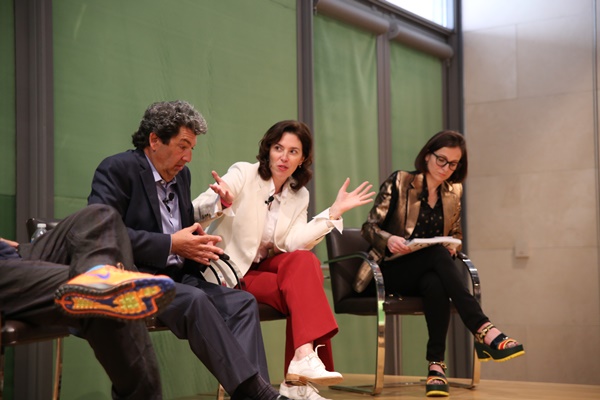
Over 200 people showed up to see Sotheby’s fine art chairman Amy Cappellazzo, Hauser & Wirth partner Paul Schimmel, and controversial dealer and collector Stefan Simchowitz spar during the Nasher Sculpture Center’s April 16 speaker series, “Agents, Advisors, Devils and Apostates: The New Art World.”
Though the central focus of the panel, moderated by 33 Artists in 3 Acts author Sarah Thornton, was the sculpture market, the panelists traded barbs on topics ranging from private collectors versus institutions, the efficiency of the gallery model, artists, and fabrication studios.
(L to R): Stefan Simchowitz, Paul Schimmel, Amy Cappellazzo.
Photo by Andrea Devaldenebro. Image: Courtesy of the Nasher Sculpture Center, Dallas.
Simchowitz’s opinionated participation bordered on a takeover at more than one point, with Thornton having to wrest back control.
Here are some of the most noteworthy moments of the very entertaining afternoon.
1. Simchowitz is the Donald Trump of the art world
“In terms of style if not substantive politics,” said Thornton, “Stefan is our Donald Trump of the art world. He’s an anti-establishment disruptor and has an affinity for the media.” Simchowitz bristled and then humorously said, “I’m voting for Hillary.” Thornton in turn, cast Cappellazzo as Hillary Clinton and Schimmel as Bernie Sanders, to laughs from the crowd.
2. Sculptures should fit in the elevator paths of the most expensive buildings in the world
“What kind of sculpture sells well?” Thornton asked Cappellazzo, to which the latter responded, “Commercial ones…. Things that fit in the elevator paths of the most expensive buildings in the world. Things that don’t require reinforcing your floor for your neighbors below.”
3. Warhol and Koons are “crap”
After a few minutes discussing records at the top of the market, such as for Alberto Giacometti and Jeff Koons, Simchowitz clearly felt too much attention was being focused on Koons’ market, and he pushed back. “Who cares?” he said. “Why do we always have to discuss Warhol and Koons?” He added, it’s “the same old crap.”
4. Private collectors vs. museums
“This ridiculous separation between the private institutions and the superiority of the collector is rubbish,” said Simchowitz. Praising Sterling Ruby, he said, “The guy is a god. He puts a sculpture. His friends come and see it. It’s the same thing. Art lives in collectors’ houses. It gets seen in collectors’ houses. It lives and breathes there, so this differentiation needs to be obliterated.”
5. Who’s worse, collectors or museums?
“Artists like to see their pieces go to a place where it’s going to stick, meaning not get turned around and maybe stored,” said Schimmel. Simchowitz jumped in and said, “You mean at a museum that has so much work they never show it?”
“So the good thing about sculpture, if you sell it to this guy,” said Schimmel, “he’s known as a flipper—something big enough and hard enough, it might actually stick for a while.”
“I think anyone who buys something and puts it in their backyard should be applauded,” said Simchowitz. Micro audiences in aggregate build huge audiences.”
6. Art ain’t nothin’ but bitches and money
In a less-weighty back-and-forth between Schimmel and Cappellazzo about editioning and posthumous casting, he said of an artist’s original intent and materials, “I’m not saying it’s sacred or religious,” to which Cappellazzo quipped, “Yes you are,” drawing laughter from the audience. Schimmel continued: “Because hey, I think Jeff Koons turns those fabricators into his bitches and gets things that are unbelievable.” Cappellazzo added: “God bless the bitches, right?”
7. The media is corrupt, corroded, and underpaid
During the question and answer session that followed the panel, artnet News asked Simchowitz what he thinks the problem is in terms of his generosity being misconstrued. We got the following earful as a result: “One of the areas where philanthropists need to invest is in media reform—which has essentially obliterated our ability to run a democracy. The media is corrupt, corroded, underpaid, and essentially writes profound amounts of bullshit that basically gets clicks on a website. They don’t analyze systems. They want a devil—so I’m on this panel…. I sued [Ghanaian artist] Ibrahim Mahama. I got emails from people all around Africa saying, ‘Please, abuse me. We’ll send you artwork.’ I’ve got emails from Lagos to Addis Ababa to Kinshasa. So you know what? It’s been great for business. I like being demonized. So I can get an audience and essentially spread my strategies.”